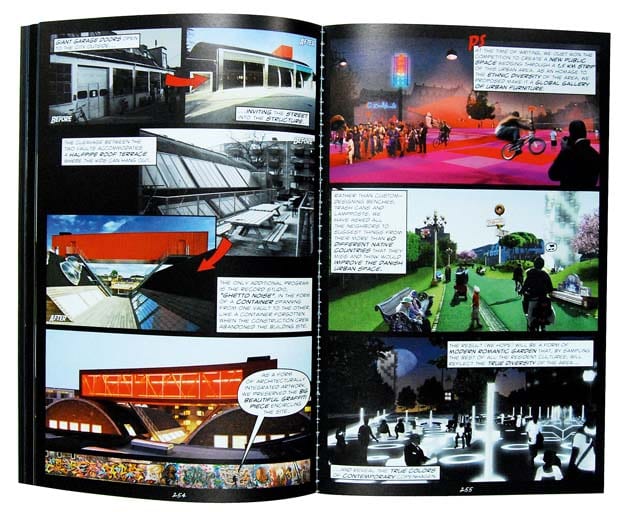
words William Wiles
While reading Yes is More on the Tube, something unusual happened. I noticed that it was being read over my shoulder by my fellow passengers. That normally doesn’t happen with architectural monographs. But Yes is More isn’t a normal monograph. Instead, it’s an “archicomic”, produced by BIG, the architectural practice of Danish prodigy Bjarke Ingels (icon 067). It details BIG’s projects to date, built and unbuilt, in the style of a comic book, with panels, speech bubbles and an excitable manner.
This isn’t a new approach – Archigram’s magazines, with their pulpish collaged aesthetic, are an obvious precedent. More recently, Rem Koolhaas’ AMO/OMA – the studio in which Ingels earned his spurs – produced Content, a chaotic tract that riffed on comics as well as magazines and the froth of network culture. But Ingels does not share Koolhaas’ prickly contrarianism. He’s the cuddly version of Rem.
Yes is More is relentlessly affirmative and accommodating – BIG’s philosophy is a big tent. “Rather than being radical by saying fuck the establishment, fuck gravity, fuck the neighbours, fuck the budget, fuck the context – we want to try to turn pleasing into a radical agenda,” said Ingels in the manifesto BIGamy, published in icon 050. In Yes is More, BIG demonstrates what this means in their day-to-day work. “The true origin of an architectural project is often an untold story,” says Ingels in the introduction. “The process is too prosaic, too inconsistent, and too unheroic to convince. This is an attempt to unveil the chaotic conditions under which we work.”
The result is a detailed look at the thought processes of one of the most interesting architectural practices at work today. In the course of these explanations, BIG outlines the “yes is more” philosophy – the radical agenda mentioned above, an ideology without ideology. A typical project description works like this. A seemingly straightforward brief is made complicated by an awkward site, or contradictory demands from the client, or some restriction imposed by Danish planning law. BIG’s response is a dazzling counter-intuitive shift in understanding, which involves flipping the whole structure upside-down, or sending Copenhagen’s landmark “Little Mermaid” to China. A bizarre form is then tweaked and nudged to accommodate the programme or to take account of solar gain, with an outcome that looks outlandish, but is in fact wholly rational.
This lateral approach is most enjoyable when it takes on Danish planning codes that limit the possible height and massing of buildings. These codes carve out readymade volumes of air. BIG just calculates the volume and fills it up with programme, following the code to the letter and producing a result utterly unlike anything the planners might have expected. “Instead of going above and beyond the rules, we decided to push to the edge of the regulations,” Ingels explains, “to inflate our building until it hit the invisible immaterial boundaries … to discover the hidden beauty of bureaucracy!”
The emphasis is Ingels’ – this is a comic book, remember. But why a comic? In the introduction, Ingels explains that the form was chosen to “transmit the energy of a face-to-face encounter with an architect”. In fact, what it does is to transmit the energy of an encounter with Ingels, whose enthusiasm and passion for architecture is refreshing and contagious. He’s a powerful advocate for his profession, and Yes is More is a lightning-bolt of excitement and a tonic against cynicism.
Yes is More: An Archicomic on Architectural Evolution, by Bjarke Ingels Group www.big.dk
Look out for our interview with Bjarke Ingels in the January issue of icon (079) out at the beginning of December.

















